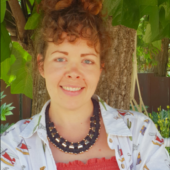Innovative bee tracker measures real-time pollination, supercharging yield and profit
Australian agritech startup, Bee Innovative is revolutionising the centuries-old practice of commercial pollination. Its groundbreaking technology gives growers a real-time insight into how well bees are pollinating a crop, enabling interventions that boost yield, quality and profitability.
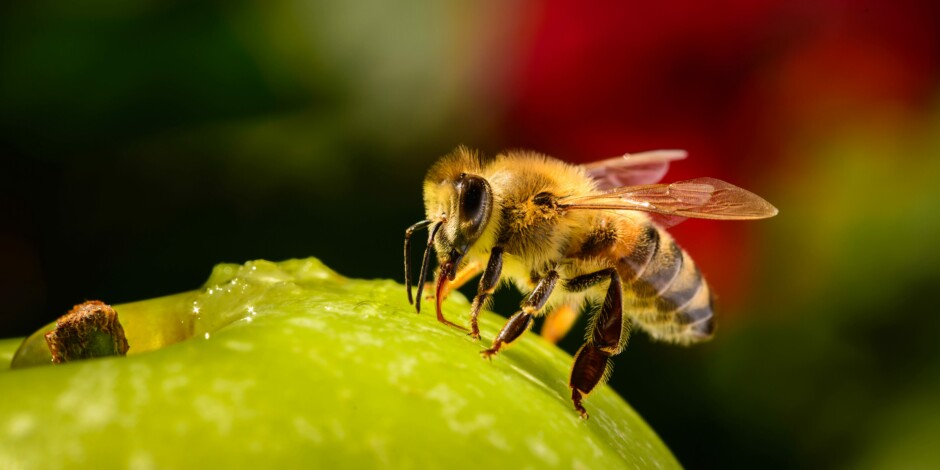
Bees are the lifeblood of the food chain – responsible for pollinating one third of Australia’s food – and protecting their existence has never been of greater importance.
“There are so many remarkable advancements in modern cropping: plant breeding and genetics; real-time measurement and application of water. But commercial pollination is still just a hive placed in a field and the grower crossing their fingers that the bees do a good job. It’s the same practice that my father used, and his father before him,” explained David Lyall.
For commercial beekeepers and Co-Founders of Bee Innovative, David and Kate Lyall, this practice was well overdue for a shake-up. Their solution is BeeDar, a supercharged approach to pollination that allows growers to significantly increase yield, and yield quality, without additional irrigation, fertiliser, or land. “Effectively what we’re doing, is helping the natural behaviour of bees become more efficient – and more profitable,” said CEO and Co-Founder of Bee Innovative, David Lyall.
David Lyall presenting at the evokeAG. 2020 Local Startup Showcase
By measuring where bees are working in a crop, the BeeDar sensor identifies problem areas, informing decision-making that optimises pollination outcomes. Attached to a drone, BeeDar works like a short-range radar, identifying whether a return signal belongs to a bee, and even whether that bee is a European honey bee or a native stingless bee.
“It’s a bit like a radar at an airport that puts a signal out into the air and the information bounces back allowing the radar operator to distinguish between a passenger jet and a military jet,” explained David.
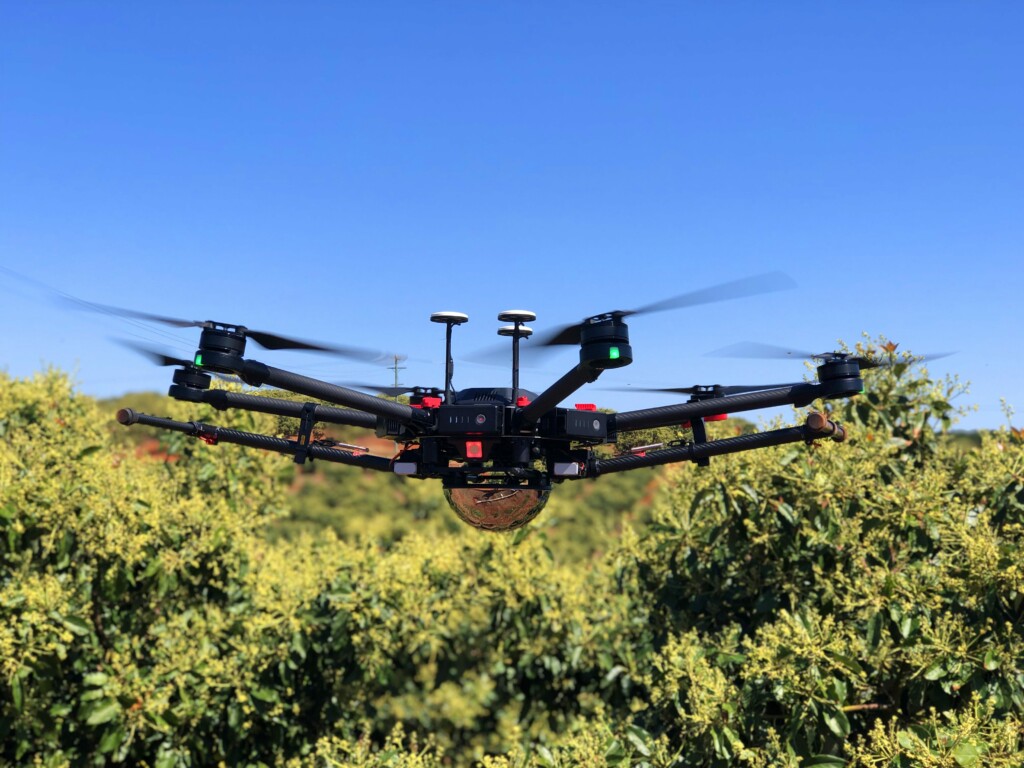
What’s remarkable is that the objects the BeeDar distinguishes are 4 millimetres long, not 70 metres long.
“Whether it be two acres or 2,000, we fly over the crop and map the distribution of where bees are working. Or more importantly, where they’re not. We often find there are significant sections that are under-pollinated or have such low levels of bee activity that it almost isn’t being pollinated at all. For the grower, that’s a real impact on yield and profitability.”
To give an accurate measure of pollination activity, BeeDar flies three missions per day – early morning, midday and afternoon – over three days, to account for the variables that can impact pollination outcomes. Weather is one, with bees hanging up their tools when it’s too cold, windy or wet.
Proximity is another. “As a community, bees work to provide three resources to the hive: nectar, pollen and water,” explained David. “If they can find everything they need within a short distance of the hive, they won’t travel further. They’re like us. If we want McDonald’s and there’s three on the highway, we’re not driving all the way to the third.”
Clever user interface translates complex data into meaningful insights
It can be tempting with data rich services to overengineer the user interface – or as David describes it, “dazzle everyone with bells and whistles”. “But we’ve done over 1,000 customer interviews in our four years of operation, and learned that growers just really want to know three things: ‘Is there a problem? Where? And how do I fix it?’”
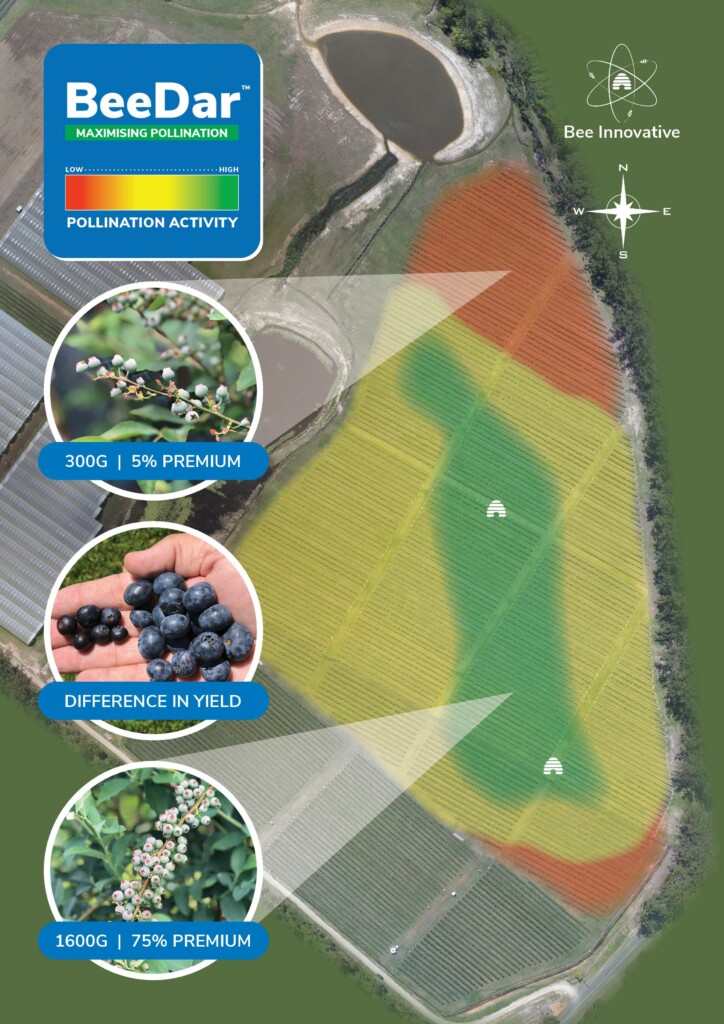
BeeDar’s approach is a simple colour-coded heatmap. “Green means pollination is going well. Yellow means that area is okay but could be improved. Red signifies a major problem,” explained David.
Because bees use local landmarks to navigate back to their hive, addressing trouble spots isn’t as simple as shifting hives midway through pollination. To act on BeeDar’s insights while working with the bees’ natural behaviour, Bee Innovative supports growers on a multi-year contract basis.
“It’s a continuous quality improvement program. We’ll go in in the first year and map what’s happening, then make recommendations to optimise pollination for the following year. We keep finetuning it over the next year or so, offering more insights and more improvements.”
“For a tree crop, that two to three-year continuous quality improvement program delivers benefits over the life of the trees – which might be 20 years – because some physical variables that influence bee behavior within that crop don’t change year on year.”
But Bee Innovative also supports growers seeking an immediate response, working with commercial beekeepers to map pollination activity as soon as bees arrive on farm. If any trouble spots emerge, the beekeeper can place the last hives accordingly.
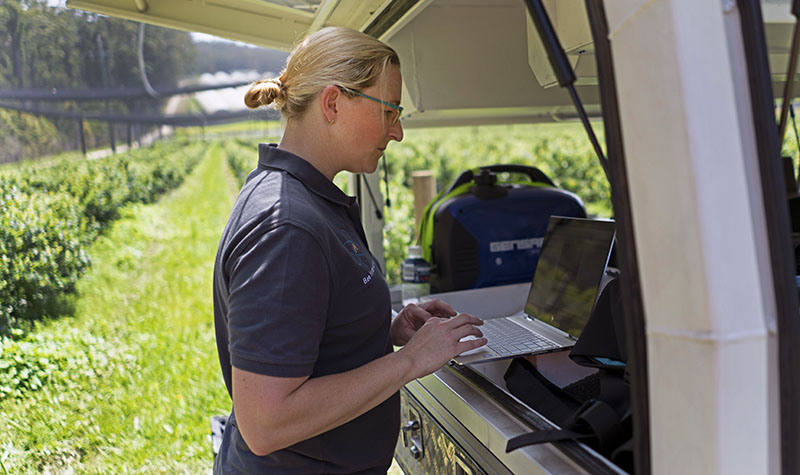
Bee Innovative Chief Technology Officer and Co-Founder, Kate Lyall working with the BeeDar technology. Supplied.
Growers are embracing BeeDar technology
While growers of tree and berry crops have been enthusiastic adopters, David is also seeing increased interest from the broadacre sector, particularly in seed production. And with nearly 100 pollination-responsive food and fibre crops across the world, BeeDar’s potential is immense.
“Pollinated agriculture is estimated to be a $14 billion industry in Australia alone,” said David.
While the focus to date has been on the domestic market, with the help of Austrade, Bee Innovative is preparing to tackle the US. But that’s just the beginning. “Whether it be Africa, Central-, South- or North America, or Europe; almost anywhere, where people are growing crops that involve flowering, we’ve had strong interest.”
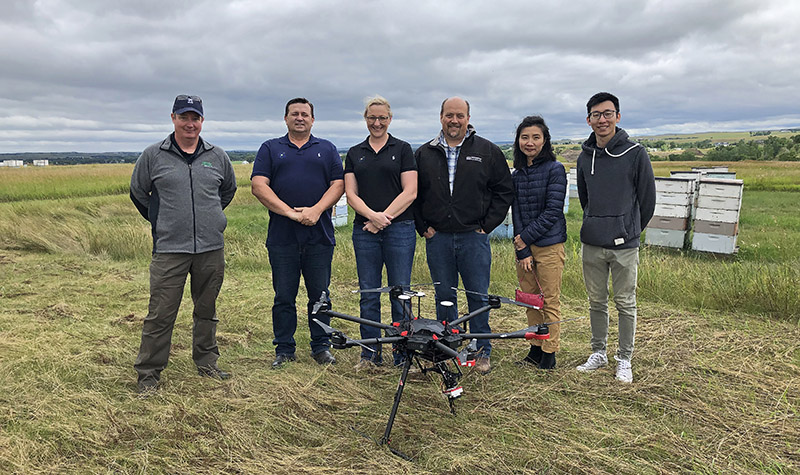
UAS operations conducted by the University of North Dakota and Bee Innovative over two sunflower fields near Bismarck, North Dakota in August 2019. (Left-right) UND UAS pilot James Moe, David Lyall, Kate Lyall, Paul Snyder, Haochi Zheng and student Jiyang Zhany. Photo courtesy of UND Aerospace
Just a few short – COVID-interrupted – years into operation, Bee Innovative has achieved remarkable commercial success. “But we haven’t done that in isolation,” explained David. “We can’t be a specialist in all areas, so we definitely benefit from partnering with others who can help us on our journey.”
“Like most startups, we had early successes and utter failures developing the tech. A partnership with one grower organisation [in 2018], is what helped us move from the bench to a full-scale field trial. BeeDar had such a profound impact on that crop that year, that we haven’t looked back.”
“I tip my hat to CSIRO’s ON program, which really helped us to fast-track the technology and understand how to be a successful startup,” said David. “And to the Australian Government, whose support helped us establish a tech partnership with the University of North Dakota, USA – specialists in autonomous technology. Drone tech is accelerating so rapidly, and this partnership allows us to focus on what we do really well, which is understand bees, and leverage what others are already experts in.”
BeeID technology set to play an important role for Australian biosecurity
What started as a conversation over a cup of tea about future-proofing their beekeeping business for their children now has the potential to be a critical first line defence against exotic bees and bee diseases. Bee Innovation’s other groundbreaking tech, BeeID, sounds like something out of a sci-fi movie.
And the recent detection of Varroa in the Port of Newcastle, further demonstrates the importance of cutting-edge technology in the early detection, tracking, and eradication of incursions, including Varroa’s natural host, Apis cerana, the Asian honey bee. BeeID utilises advanced facial recognition technology at monitoring stations, which can be placed around Australian ports, BeeID assesses the shape of a bee’s face, the distance between the eyes and other physical characteristics, to identify the good bees from the bad ones.
“In less than a second, we’ve demonstrated 97% accuracy in distinguishing between the European and Asian honey bees,” said David.
Once a bee exits the monitoring station, there is potential for a BeeDar drone to follow it back to the hive, enabling biosecurity authorities to quickly eradicate it before it has the chance to mingle with our ‘wild’ bee population.
With more than half of pollinated agriculture in Australia performed by wild bees, the loss of our domestic bee population to varroa mite would be catastrophic for Australian food production. Not to mention commercial beekeeping. “BeeID really is our passion project,” said David.
“We work with different beekeepers in the US, and a 40 or 50% loss in hives every year due to Varroa is not an unusual number. Trying to work with Varroa proves we’re far better off without it.”
Interested in learning more about Bee Innovative’s BeeDar or BeeID technology? Get in touch here. Or connect with David and Kate Lyall at AgriFutures evokeAG. 2023 in Adelaide, 21-22 February 2023. Early bird tickets are now on sale here, until 4 August 2022.
David Lyall
[email protected]
Phone – +61 0420436241
www.beeinnovative.com.au
Enjoyed this story? Want to learn more about the Asia Pacific region’s innovative agrifood tech ecosystem? Sign up for our newsletter here and receive fresh stories about global leaders, farmers, startups and innovators driving collaborative change.
